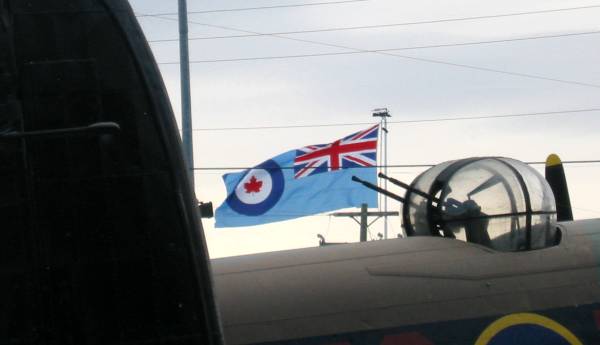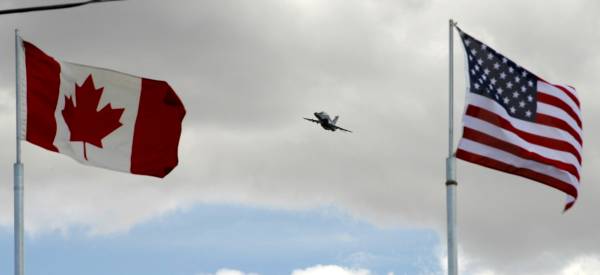 Museum
Museum  |
Bomber Command
|
Aircrew Chronicles
|
Aircrew Losses
|
Nose Art
|
BCATP
|
Lancaster
|
Media
|
Bomber Command
|
Aircrew Chronicles
|
Aircrew Losses
|
Nose Art
|
BCATP
|
Lancaster
|
Media
 Museum
Museum  |
Bomber Command
|
Aircrew Chronicles
|
Aircrew Losses
|
Nose Art
|
BCATP
|
Lancaster
|
Media
|
Bomber Command
|
Aircrew Chronicles
|
Aircrew Losses
|
Nose Art
|
BCATP
|
Lancaster
|
Media
Bomber Command Museum Archived Newsletters
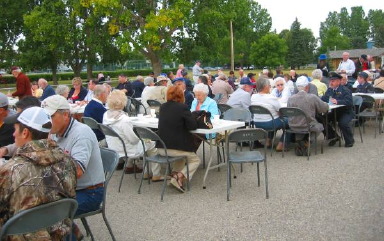 Some of the crowd at the outdoor breakfast. |
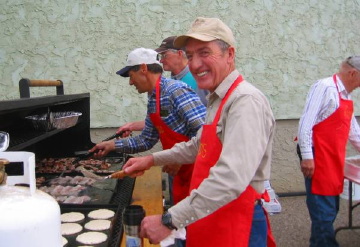 Smiling Lions cook breakfast for those attending. Lions members are always pleased to help with the fly-in and have donated the breakfast funds back to NLS. |
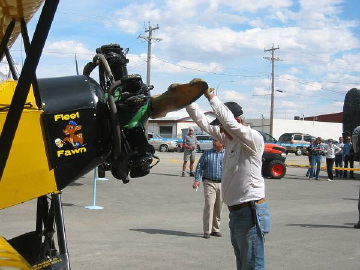 John Phillips "swings the prop" to start the Fleet Fawn's Kinner engine. |
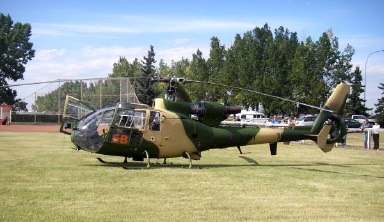 BATUS Gazelle helicopter lands with British crew to attend the August 25 event. |
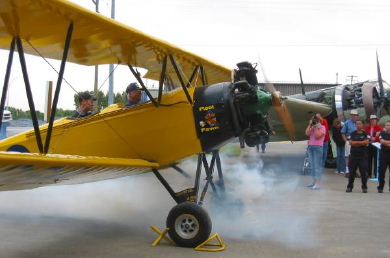 The Kinner starts with a bit of smoke. |
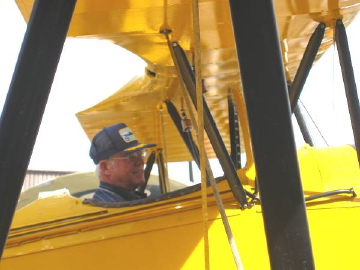 Larry Oakman from Swift Current, Sask., in the Fleet's front cockpit. Larry's dad, Ernie donated this aircraft to NLS in 1990. |
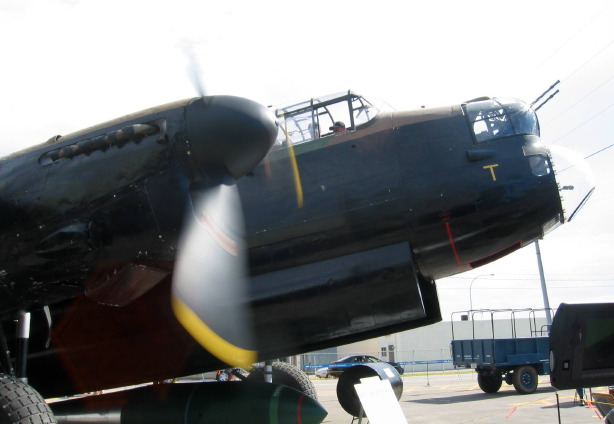
|
During our summer event, Dick Anderegg, Director of History and Museums for the United States Air Force, and Gordon Symons officially opened a set of three permanent display panels that introduce the history related to the Americans in the RCAF. One of the panels lists the names of 753 American airmen who were killed while wearing our country's uniform. Gordon and his two brothers were all wartime RCAF pilots. He is the author of "The Boys of Spring." We were pleased that he chose our summer event for the official launch of his book. As well, Gordon sponsored our new display. NLS very much appreciates his contribution. Gordon Symons, Dick Anderegg and NLS president, Rob Pedersen, in front of the newly opened American exhibit. |
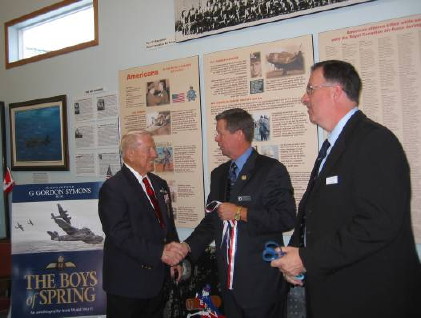
|
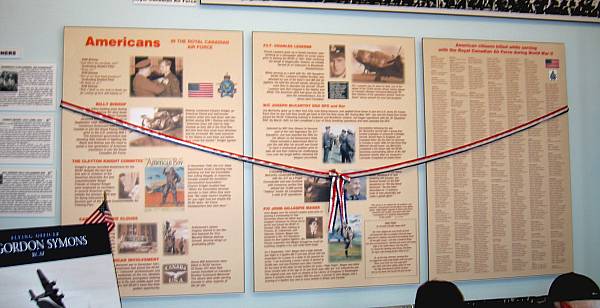
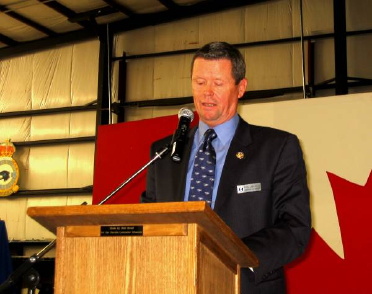 Dick Anderegg, Director of History and Museums for the USAF, spoke to the luncheon crowd about the joint efforts of Canadians and Americans in WWII. |
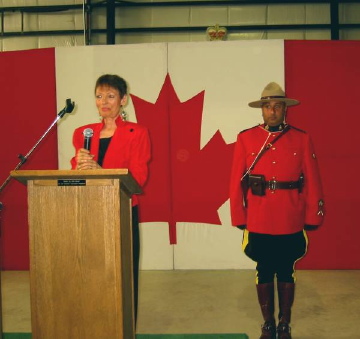 Judy Armstrong sang O'Canada and The Star Spangled Banner to open the indoor ceremonies. RCMP Cst. A.J. Mand stands at attention. |
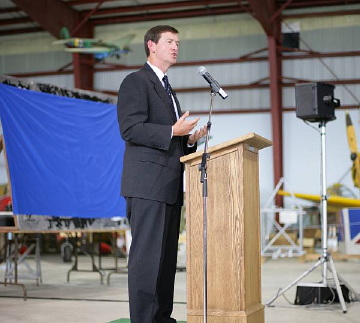 Thomas Huffaker, American Consul General, from Calgary, brought greetings to those attending the August 25 event. |
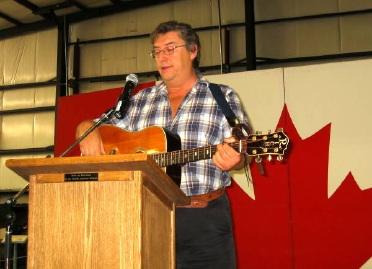 Jim Blondeau sings "The American Eagle," a song he had written specially for the NLS event, honouring the Americans who had served with the RCAF during WWII. |
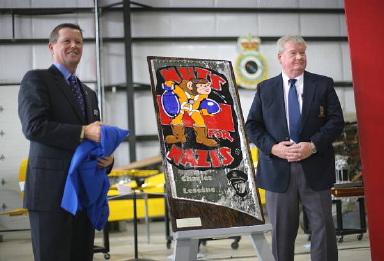 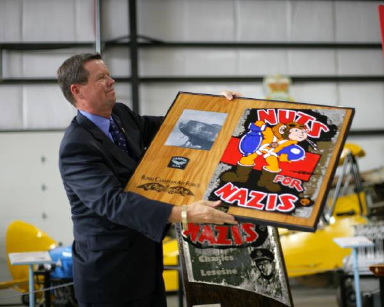
|
<== Dick Anderegg and Clarence Simonsen unveil the "Nuts for Nazi nose art. 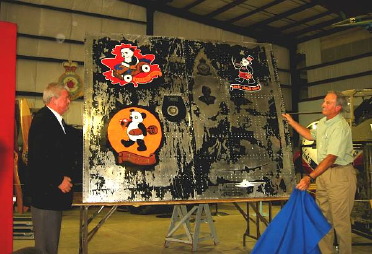 Clarence Simonsen and Joe McCarthy Jr. unveil the nose art panel dedicated to Joe McCarthy Sr., an American Volunteer who took part in the WWII Dams Raid. <== Dick Anderegg received a replica nose art to take home to Washington D.C. |
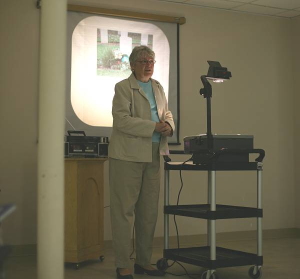
|
Biographer Linda Granfield, held two seminars on the morning of August 25, to start off the day that saluted the Americans in the RCAF. She talked about the life of WWII Spitfire pilot, John Gillespie Magee, an American who volunteered with the RCAF at the beginning of WWII. The NLS extends THANKS to Linda for her contribution to this summer's event. Linda Granfield, conducting a seminar about the life of John Gillespie Magee, who wrote the well-known poem "High Flight," at the NLS summer event. |
MLA David Coutts brought greetings from the Province of Alberta to those who attended the August 25 event. As a great supporter of our aviation museum, David was instrumental in finding major funding (Lottery Funds) which has allowed us to complete Phase I of the 14,000 square foot building expansion. We owe David a debt of gratitude for this boost to our growing museum. David has recently announced that he will not be standing for re-election in the next provincial election. We hope his replacement has the same vision for constituency tourism and the preservation of history that David has demonstrated. Our Society wishes David "all the best" in his retirement. Member of Legislative Assembly of Alberta, The Honourable David Coutts, addresses guests at the August 25 event luncheon. |
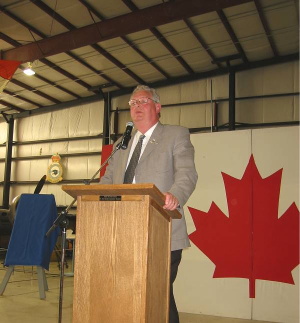
|
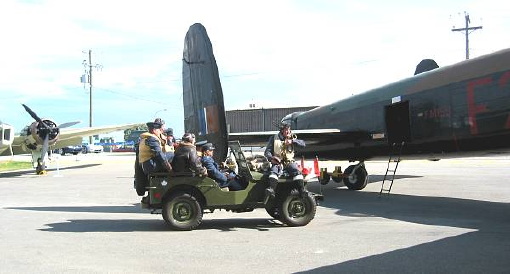
|
A new dimension was added to this year's summer event with the participation of eleven "Re-Enactors" or "Living Historians." Travelling from as far away as Winnipeg and Oklahoma, they were introduced to our Society when we were both involved in the 2006 Oshkosh Air-Venture. The Re-Enactors arrive at the Lancaster riding in the museum's Jeep (on loan from Jerry Barthel of Lethbridge) to get ready for a "Night Op." |
Dressed in authentic RCAF uniforms and with a thorough understanding of the history, they remained "in-character" throughout the event. An entire "crew" drove up to the Lancaster in our jeep and climbed into the aircraft prior to its start-up. Wartime songs were sung at various times, and great photo "ops" were constantly available to our visitors. The Re-Enactor "crew" just before taking up their positions in the bomber. Note the authentic WWII flying gear. The real wartime crew ladder at the entry door is always kept with the Lancaster in case it is needed by crews to board the bomber for such operations. |
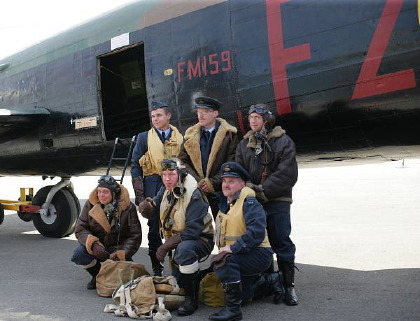
|
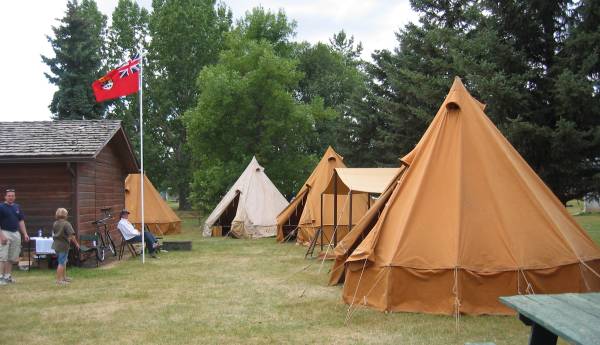
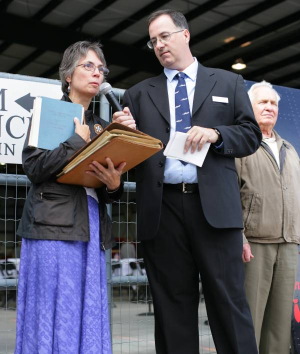
|
The museum is honoured to be entrusted with the medals, logbook, and archival material related to S/L Donald Patterson of Calgary. It was appropriate his family presented this memorabilia at our "Americans in the RCAF" event, as Donald's crew included American Frank James, Waco, Texas. The Patterson Collection is one of the museum's most extensive sets of archival material related to a single individual. M.J. Patterson, S/L Patterson's daughter, together with Bill Bessent, the mid-upper gunner on the crew, unveiled a spectacular, nearly full-size replica of "Willie the Wolf of the West," the nose art that was carried on S/L Patterson's No. 426 Squadron Halifax. Visit "The Clarence Simonsen Collection" at www.lancastermuseum.ca to view this replica and all of Clarence's paintings held by the museum. M.J. Patterson presenting S/L Don Patterson's log book, medals, and memorabilia to NLS President Rob Pedersen at the August 25 event. |
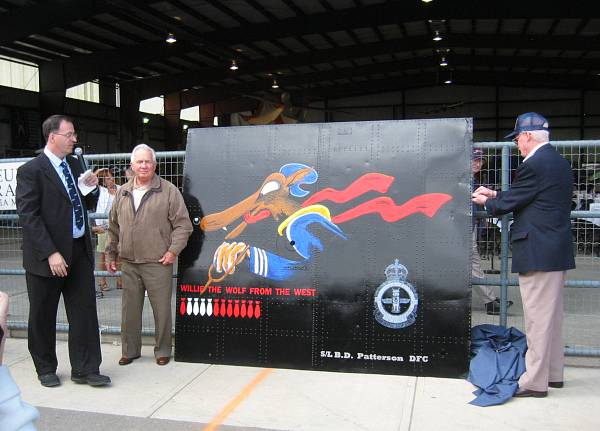
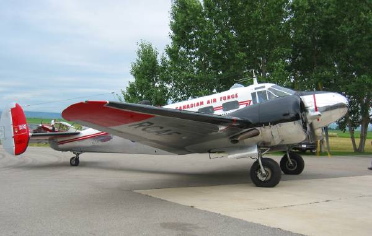 Sunwest Aviation's restored Beech Expeditor attended the NLS July fly-in. This aircraft has been in attendance at nearly all fly-ins in past pears and is always a crowd pleaser! Our thanks to Sunwest Aviation and their pilots for adding greatly to the day. |
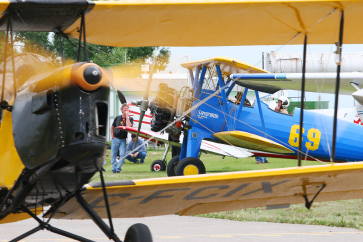 Alex Bahlsen's Stearman as seen through the wings of Gordon Johes' Tiger Moth. |
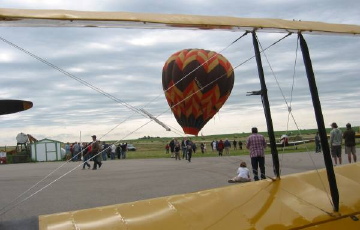 The tethered balloon added to the day. |
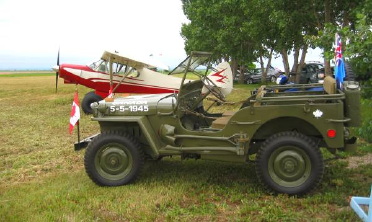 Jerry's Jeep with a supercub at the fly-in. |
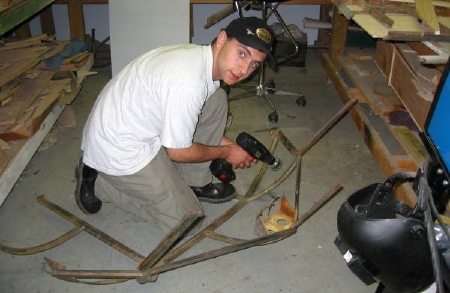
|
Philippe and Franc6ise Uziel, along with son Guillaume, of Paris, France, visited with Bob and Carol Evans in July and attended the 2007 NLS fly-in breakfast. NLS members may remember that Guillaume had travelled to Canada in 2002 with the goal of working on a Canadian Lancaster bomber. He spent a week with the Evans family and spent some of those days working in the museum shop. True to form, during this visit he again insisted on spending a few hours in the museum shop, where he worked at cleaning up the Avro Anson windscreen frame. Guillaume is busy working on the Anson windscreen frame. |
Not to be outdone, his father Philippe has committed himself to translating the museum's pamphlets into French so that this information would be available to French speaking tourists. Philippe has already sent back translated text to be incorporated. Philippe and Guillaume have volunteered at the Paris aviation museum, Ailes Anciennes, where the lone French Lancaster is being restored. They left Nanton enthused and eager to again add their efforts to that of the other volunteers at the Ailes Anciennes in restoring Lancaster NX664. We extend THANKS to Guillaume and Philippe for their efforts in making the museum better! From L-R. Guillaume, Francoise, Philippe Uziel and Carol Evans share a laugh at the annual NLS Fly-In. |
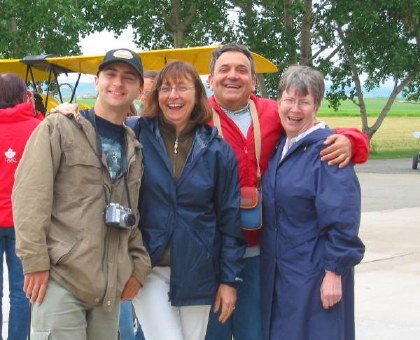
|
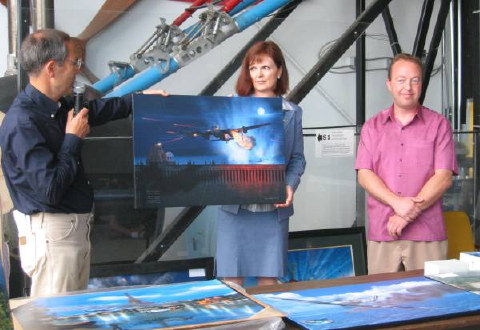
|
During our summer event, Shere Lowe presented a print of the spectacular painting that she commissioned Len Krenzler to complete depicting John Hopgood's Lancaster over the Mohne Dam. F/Lt. Hopgood's aircrift was the second to attack and was set on fire. Hopgood successfully gained enough altitude for Shere's father and one other crewman to escape but the pilot and the other crewmembres were killed shortly after the moment depicted in the painting. After having the painting framed, it was hung in the front entrance of the museum on a Saturday morning. An hour later Jim Heather entered the museum and began chatting with one of our volunteers. He mentioned that his uncle's name was on our Memorial Wall and our volunteer asked who his uncle was. Jim's uncle was Ken Earnshaw, the navigator on John Hopgood's aircraft. Visit "The Dams Raid" section of our website to view Shere's painting and read about John Hopgood and crew and www.actionart.ca to learn about Len Krenzler's amazing artwork. |
|
The initial phase of our project was completed during the summer. We are pleased to have the initial 90' x 160' basic building expansion, c/w a concrete floor, heat tubing in the floor, and the storage mezzanine in place. The new area will be used for storage and some aircraft restoration work. Phase II will enable us to: install a sprinkler system throughout the entire building (current building code requirement); construct interior walls to divide off the restoration shops at the west end of the new area; create a "multi-purpose" room for school and other groups' large meetings; expand our small-artifact and interpretive display area; add another washroom; and incorporate a mezzanine area that will be available for additional displays and as a visitors' viewing platform for the entire building. Once this is completed, our existing shop areas would then be removed, enabling visitor access to the entire building. Plans are also in the works to heat the entire building using a solar, geo-thermal system. As things stabilize following our completion of Phase I, we are now actively working towards the necessary fund-raising to begin future development. If you have ideas as to how we might attract corporate and other financial support, please let us know. |
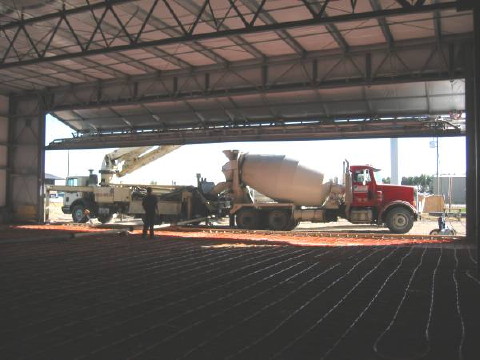 First concrete arrives to pour the floor. |
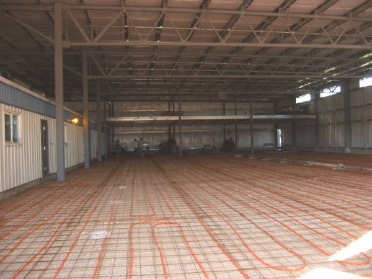 In-floor heat tubing - ready for concrete. |
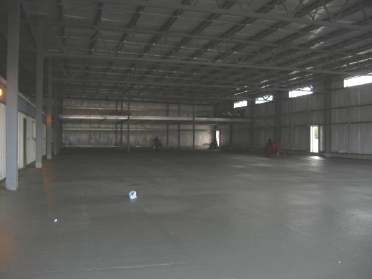 Concrete floor & mezzanine above shop area. |
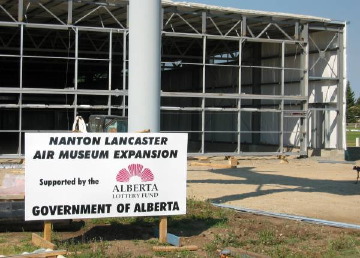 Signage indicates the museum addition is supported by funds from the Government of Alberta through the Alberta Lottery Board. |
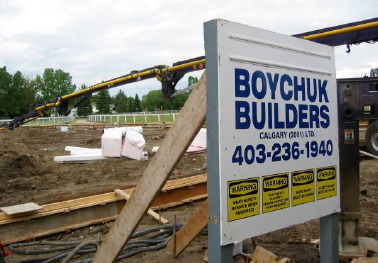 Boychuk Builders Ltd., was the contractor for the Phase I construction of the addition to the museum. |
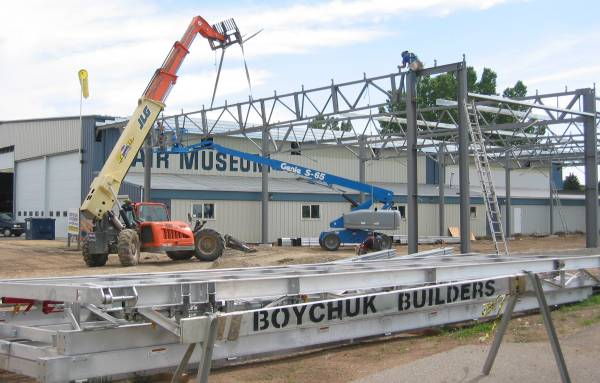
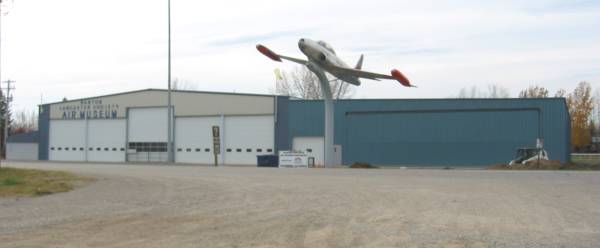
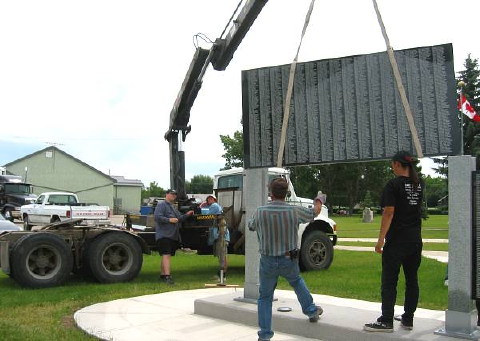
|
One of the black granite panels on the Memorial Wall was changed in early August. Several of our 50,000+ visitors of the past couple of years, who have seen the memorial, have noticed that there was a discrepancy in the one panel. One whole row of names were inadvertently left off the original panel. The new panel corrects this oversight. Setting the new panel in the Memorial Wall. |
With the help of Dan Hjalte and his "picker" truck, the original panel was removed and the new one installed. NLS extends a special THANKS to Dan, who has helped museum with lifting other items in the past. The panel in place - it was polished later. ==> |
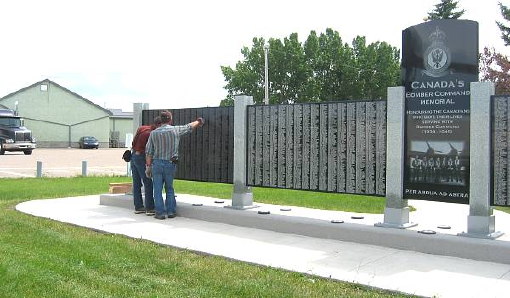
|
|
The metal ingots shown in the photo below are from the remains of Halifax LW 682 which was removed from a Belgian bog a few years ago. NLS members Jay Hammond and Karl Kjarsgaard were involved in putting this recovery together. The remains of three Canadian crew members still in the aircraft were recovered and given a proper burial. Parts of LW682 were salvaged for restoration of the Halifax in the RCAF Museum, Trenton, Ontario. The remainder of LW682 was smelted down and shipped to 426 (Thunderbird) Squadron Association at Trenton. As storage became a problem, Karl Kjarsgaard along with Larry Motiuk (426 Squadron) arranged with NLS to accept and store the ingots. The 426 Squadron Association and the Air Force Museum retained several ingots for heritage purposes. The remaining 1700 pounds are now safely stored at Nanton. |
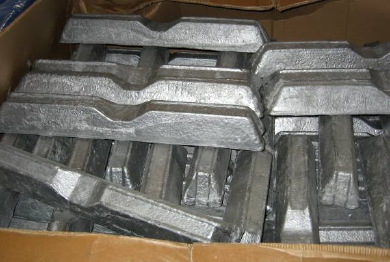
|
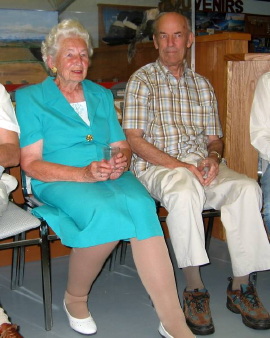
|
This past summer the Society said goodbye to two extraordinary, long-time volunteers. Keith and Pat Phillips have moved to Edmonton to be nearer their family. They have both been associated with the NLS almost since its inception. They have volunteered in many ways to help make the museum a success. Both Pat and Keith have manned the reception desk, signed up many additional volunteers, helped organize events, raised funds, and helped with anything else that needed doing. The Phillips were also very involved in other aspects of the Nanton community. Their volunteering was not limited to just the museum. All their NLS friends wish Keith and Pat all the very best in their new home. Pat and Keith Phillips. |
|
After a trade with Darrell Brown in Ontario, our museum now has the bare beginnings of a "Battle." Darrell delivered the instrument panel (as shown in the photo above) when he delivered a truck from Ontario to a friend in Alberta. He has more "bits" of this aircraft type which he will deliver next year when he travels to Nanton to pick up traded Bolingbroke parts. Curator Bob Evans has been searching for Battle parts for some time to make up a display of this aircraft which was used on BCATP Bombing and Gunnery bases across Canada, one being situated at Lethbridge.  Fairey Battle instrument panel and partial forward frame is another museum project. |
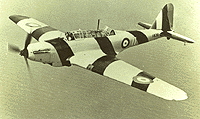 A wartime Fairey Battle in flight. Note the training aircraft, paint scheme stripes. |
|
Joe English has talked about building an airplane for a number of years. He's finally doing just that along with friend Peter Uithuisje. (Peter is originally from Holland where he has flown ultra light aircraft.) Joe English, of course is Nanton's resident former WWII Lancaster pilot. With Peter's carpentry knowledge and Joe's drafting abilities, they are busy making the components of the all wood, two-place, Falco airplane from blueprints. The making of the initial components is going ahead in Peter's small shop. Once assembly is started they are hoping for a space in the museum's new addition. NLS members are looking forward to watching this project come together and to see Joe, who is 83, take to the air once again! Peter Uithuisje and ex-Lancaster pilot Joe English hold up two components of the Falco two place aircraft they are building. |
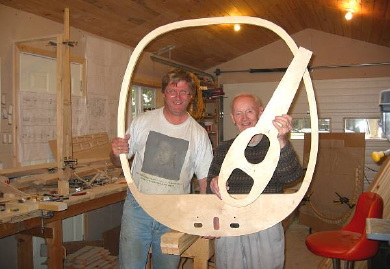
|
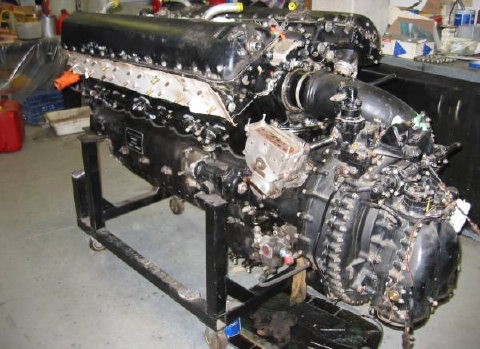
|
The on-going restoration of Lancaster FM159 continues. Merlin #4 has been in the shop for over a year but is now nearly ready to reinstall on the aircraft. The overhauled prop is now back and in the museum awaiting the installation of the Merlin. Both elevators are now back on the Lanc and the controls hooked up. They only need the final painting to match the upper area camouflage and the black underside. The second overhauled Merlin engine nearly ready to be re-installed in #4 position on the Lancaster. |
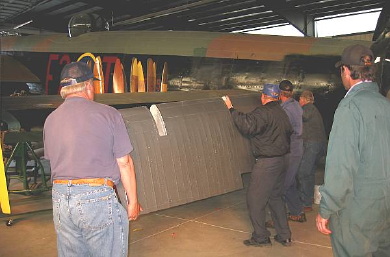 The port elevator is being re-installed on Lancaster FM159. |
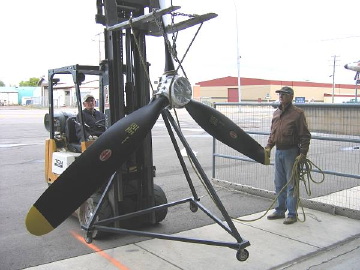 The newly overhauled propeller for the Merlin engine being moved into the museum. Curator Bob Evans runs the fork lift while John Phillips stands by. |
While the Barry Davidson Blenheim has been on display for a number of years, we had never been able to find the upper cowling sections for the Mercury engines. Due to our friend Scott Marchand, curator at the Pima Air Museum in Arizona, we now have two sets of cowlings. Scott located them in southern California (the last place we would have looked) and purchased them for us. A bit of sheet metal work will make them presentable. THANKS to Scott Marchand, the Blenheim is another step closer to being a completed display! |
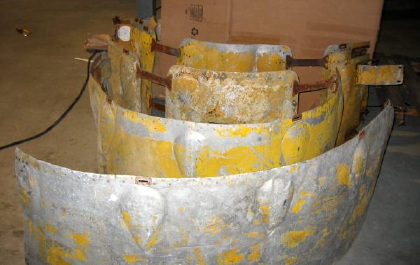
|
Former WWII truck donated by Beau Builders at Burmis, Alberta. This vehicle had not yet been hauled as the newsletter was being printed. |
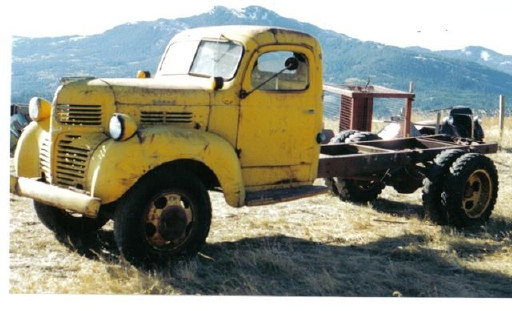
|
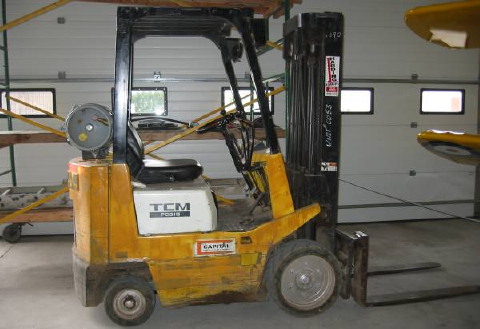
|
Fork lift donated by Ocean Trailer Ltd. of Calgary, Alberta. Their service manager, Rick Featherstone, arranged for this. Rick lives in High River and is a volunteer in the NLS shop. This machine is a very welcome addition to the museum. |
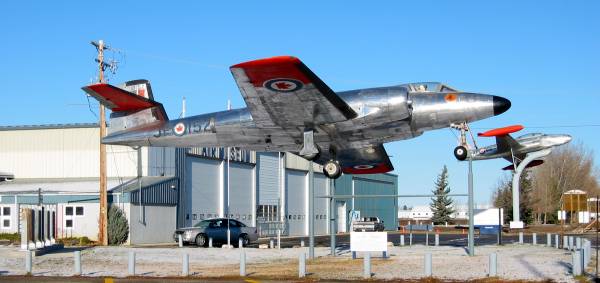
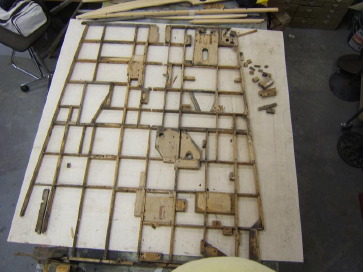
|
First we would like to welcome our newest team member Gary Amundrud. Gary recently moved to Nanton and dropped by the museum wondering if there was something that he could help with. Gary comes to us with a background in Electronics and Avionics so naturally we found a job for him working with wood. We also had some unexpected help this summer from two fellows, Chris and Colby, from the US who were visiting Canada on a Bible camp exchange. While they were up here they helped out around the museum doing various tasks but were instrumental in the stripping down and priming of our Cockpit windscreen frame. The Anson cockpit floor frame slowly coming together using as much of the original wood as possible. |
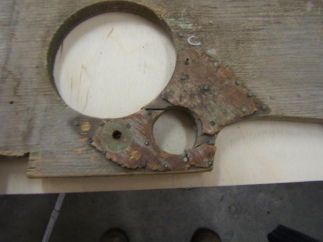
|
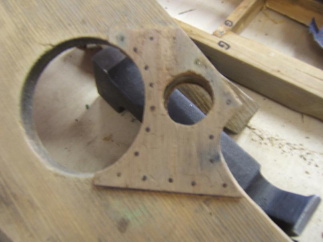
|
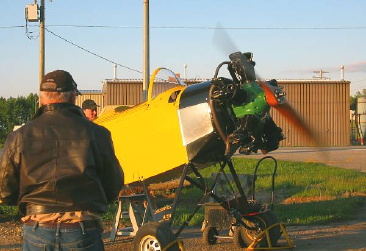 Dan Hawken watches as Greg Morrison runs up the Kinner for the first time. |
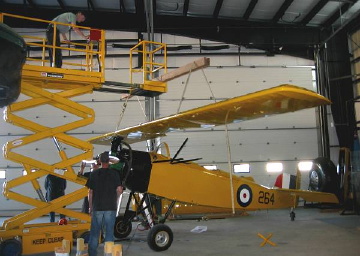 The recently acquired scissors lift was utilized in re-hanging the Fleet's one-piece upper wing. |
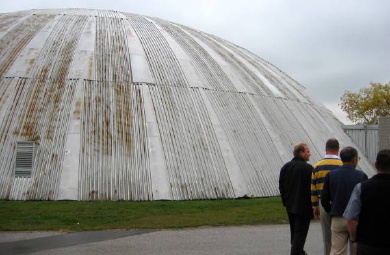
|
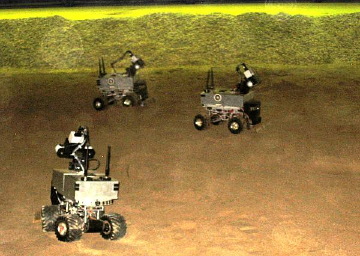
|
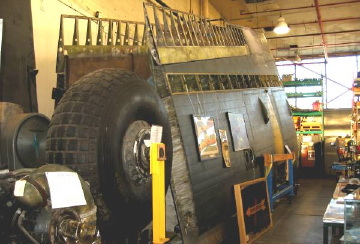 The wings and other components of FM104 are seen here as exhibited in the Toronto Aero Space Museum (TASM) |
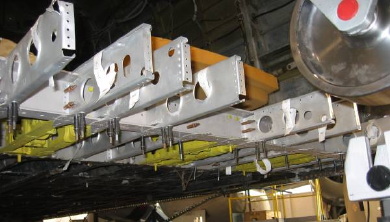 The photo shows the repairs being done to the cut away bomb bay of Lancaster FM104 by Toronto Aero Space Museum. They are using parts from Lancaster FM118 that were originally salvaged by NLS. |
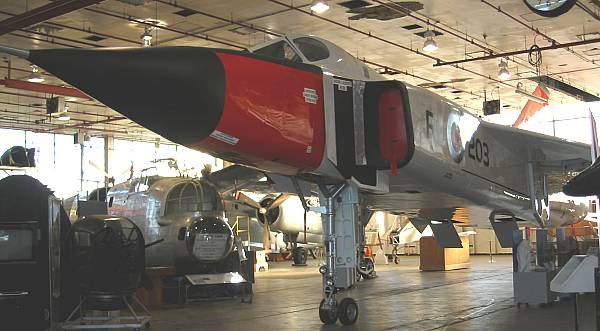

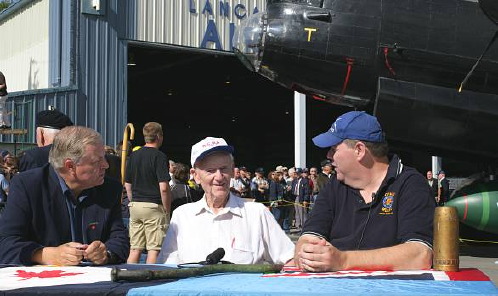
|
Air Canada Captain Karl Kjarsgaard, Joe English, and Chris Charland visiting duirng the morning of the annual event. Karl and Chris are board members of 57 Rescue (Canada). Can't you just hear them talking recovery of Halifax LW170 off the coast of Ireland! |
Author and former WWII bomber aircrew, John Neal, seen here on August 25, at a table promoting his books; "Thank You Brother Ervin" and "Lucky Pigeon." John is a long-time friend of the museum and is presently supporting the recovery of Halifax LW170 with all profits from his book sales. He is a member of the elite "Caterpillar Club" having bailed out of a Halifax bomber during WWII. |
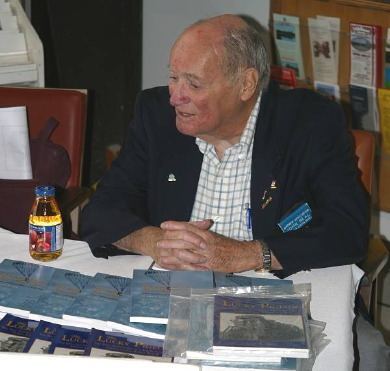
|
